Saturday, September 30, 2006
Kolmonen maaruskan takaa - Varrio peak three behind last autumn colors
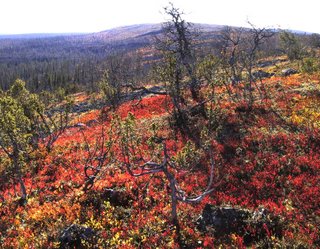
Maaruska kestää Värriössä normaalisti syys-lokakuun vaihteeseen. Lokakuu on sitten harmaa kuukausi - lumen tuloon asti. Kuva Värriö kakkosen kaakkoisrinteeltä Värriö kolmosen suuntaan.
The autumn colors on the ground (on herbs) last usually to end September. Then October is grey months - until the snow comes. Photo from Varrio peak two towards peak three.
Friday, September 29, 2006
Käpylinnun poikaset lähtivät / The youngs of Crossbill left the nest
I controlled the situation on the nest of Crossbill on Puolivälinjängänmäki on 21.9. With telescope I saw that there were at least two youngs, about to leave the nest. I estimated, that it will take a couple of days for them to leave. Today (29.9.) I didn't see any more movement in the nest.
Я проверил гнездо клеста-еловика на Пуоливялинянганмяки 21.9. С телескопом я увидел по крайней мере два птенца в гнезде, готовы оставит его. Я считал, что требует еще пару дней для них вылететь. 29.9. я не видел никакого движения в гнезде.
Mikä tappoi metsäsopulin? / Who killed the Wood Lemming?
Today (29.9.) when I was walking by the summer path, I found on the W-side of the creek Värriöoja dead Wood Lemming, without the head. Also 14.9.06 I found on the path dead Wood Lemming on the N-side of Värriö 1. A killed Wood Lemming was on the path to the E from the station in september 2-3 years ago. Does the fox do this? Sometimes we can find killed shrews, but almost never voles. Or is the situation of food so good, at this time we got a new record of catch in trapping voles.
29.9. когда я ходил по летной тропинке, я нашел мертвого лесного лемминга на запад от ручея Вярриёоя, он без головы. Тоже 14.9.06 я нашел мертвого лесного лемминга на тропинке на северной стороне Вярриё 1. Убитый лесной лемминг был и 2-3- года назад в сентябре на тропинке на восток от станций. Это лиса, кто оставляет их так? Иногда можем находить мертвых землероек, но полевок почти никогда. Или ситуация корма так хорошая? Мы сейчас сделали новый рекорд в ловли маленких грызунов.
Thursday, September 28, 2006
Hiipuvaa purppuraa - Vanishing purple

Riekonmarjan lehdet hohtavat vielä syyskuun lopulla, kunnes niiden väri hiipuu ruskeaksi. Arctostaphylos -suvun lajeista riekonmarja (A. alpinus) on kesävihanta (ja kasvattaa keväällä uudet lehdet), kun taas sianpuolukka (A. uva-ursi) on ainavihanta (sen lehdet pysyvät vihreinä kolmekin vuotta).
The leaves of Alpine bearberry shine on the ground until the purple vanishes around beginning of October. Of the species in Arctostaphylos, A. alpinus is not evergreen, whereas A. uva-ursi is. Its leaves may stay steady green even for three years.
Mustikoita maaruskassa - Bilberries waiting for snow

Lehtiruskan jo mentyä mustikan lehdet punottavat vielä maaruskassa syyskuun loppuun. Mustikat ovat jo pehmeitä poimittaviksi, mutta ne ovat paleltuneinakin haluttua kanalintujen syysravintoa. Riekot ja metsot syövät mustikoita pitkin syksyä ja vielä kymmensenttisen lumen altakin.
After the trees have shed their autumn leaves the herbs on the ground remain in autumn colors still a week or two, like the bilberries in the photo. The berries are soft for picking for human consumption but the birds of fowl eat them daily. Especially willow ptarmigans and capercaillies enjoy the bilberries until the snow and may still pick them through the snow of about 10 cm of depth.
Wednesday, September 27, 2006
Arvoitus Rakitsanvaarassa - Mystery on Rakitsa hill
 Syksyistä Lapin metsää samoava voi törmätä tällaiseen arvoitukseen. Mikä merkillinen eläin on nyljetty maassa? Vai onko joku olio luonut nahkansa?
Syksyistä Lapin metsää samoava voi törmätä tällaiseen arvoitukseen. Mikä merkillinen eläin on nyljetty maassa? Vai onko joku olio luonut nahkansa?Syksyllä porot hankaavat nahkapäällysteisiä sarviaan puunrunkoja vasten, kelovat sarviaan. Nahkan riekaleet tippuvat maahan. - Kuva Rakitsanvaarasta.
In the autumn time the hiker in Lapland forests may find a mystery shown in the photo. What is it? Has a strange animal been skinned? Or has the animal just been moulting?
These are pieces of reindeer skin that covers the newly (in the spring and summer time) grwon horns. When the mating time is appraoching the reindeers scrub the skin against trees, and the horns get their winter color and shine. The droppings of horn skins are found near to the trees that the reindeers have used in the scrubbing. - Photo taken on Rakitsa hill.
Tuesday, September 26, 2006
Kataja maaruskaisella suolla - Juniperus communis, peat bog with autumn colors behind
 Syksy saapuu pienillekin soille, kuva Värriö ykkösen luoteispuolelta. Edessä terhakka kataja.
Syksy saapuu pienillekin soille, kuva Värriö ykkösen luoteispuolelta. Edessä terhakka kataja.Autumn colors on the soils are found all around the peatbogs; the photo has been taken over a small peatbog northwest of Varrio fells. A vigorous juniper (Juniperus communis) in front.
Monday, September 25, 2006
Juolukkaa ruskassa - Bog bilberry in autumn colors

Soiden violetin ruskan, maaruskan, aiheuttaa usein juolukka, kuten tässä Puolivälinjängällä. Keltaiset väripilkut kuuluvat vaivaiskoivulle.
The violet color of peat bogs is often caused by Bog bilberry (Vaccinium uligonosum). The yellow spots belong to Dwarf birch (Betula nana).
Sunday, September 24, 2006
Orava odottaa talvea - Red squirrel waiting for winter
 Orava naksautti mennessään ja kipaisi ruskakoivuun Kuutsjoen luusuassa. Kuusen käpysato näyttää hyvältä ja oravalla pitäisi olla edessään verraten helppo talvi.
Orava naksautti mennessään ja kipaisi ruskakoivuun Kuutsjoen luusuassa. Kuusen käpysato näyttää hyvältä ja oravalla pitäisi olla edessään verraten helppo talvi.Oravan kannanvaihtelulle on tyypillistä voimakas vaihtelu. Se näkyy lumilinjan havainnoissa. Kun oravan jäljet lasketaan pitkällä lumilinjalla keskimäärin 100 kertaa talvessa,
 mittaussarjan huippukautena, 1973-1974 jälkiä kirjattiin yli 100o kertaa ja kautena 2004-2005 yli 600 kertaa. Vastaavasti mittaussarjaan sisältyy hyvin heikkoja oravakausia, muun muassa 1976-1977, jolloin vain yhdet oravanjäljet ylittivät lumilinjan koko vuonna. Vielä heikompi kausi oli 1993-1994. Silloin oravista ei saatu yhtään havaintoa (klikkaa oheista graafia suuremmaksi).
mittaussarjan huippukautena, 1973-1974 jälkiä kirjattiin yli 100o kertaa ja kautena 2004-2005 yli 600 kertaa. Vastaavasti mittaussarjaan sisältyy hyvin heikkoja oravakausia, muun muassa 1976-1977, jolloin vain yhdet oravanjäljet ylittivät lumilinjan koko vuonna. Vielä heikompi kausi oli 1993-1994. Silloin oravista ei saatu yhtään havaintoa (klikkaa oheista graafia suuremmaksi).- Oravien ja käpysatojen välistä yhteyttä ei ole vielä laskettu, mutta epäilemättä sellainen yhteys on.
Red squirrel (Sciurus vulgaris) is quite common in Varrio Nature Reserve, also near to and in the yard of the the Research Station, like this one on the shore of Kuutsjarvi lake. the seed yield of Norway spruce looks good and the Red squirrel should have a pretty easy winter ahead.
 It is typical with Red squirrel that population fluctuates strongly. This can be seen in the snowline monitoring. On average the Red squirrel tracks are counted about 100 times in the season. There are strong deaviations, however. In the winter season 1973-1974 we counted the tracks over 1000 times and in the second best season 2004-2005 over 600 times. The season 1976-1977 was poor: only one red squirrel track was seen during the whole season. The season 1993-1994 was even worse, not a single Red squirrel track came to our records.
It is typical with Red squirrel that population fluctuates strongly. This can be seen in the snowline monitoring. On average the Red squirrel tracks are counted about 100 times in the season. There are strong deaviations, however. In the winter season 1973-1974 we counted the tracks over 1000 times and in the second best season 2004-2005 over 600 times. The season 1976-1977 was poor: only one red squirrel track was seen during the whole season. The season 1993-1994 was even worse, not a single Red squirrel track came to our records.There is evident relationship between the conifer seed yeilds and Red squirrel populations. This relationship has not yet been analyzed though.
Saturday, September 23, 2006
Joko Iso Riipijä on tullut? - Has the Big Autumn Sweeper already arrived
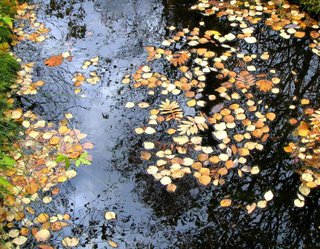 Kirjailija Kurt Martti Walleniuksella on kirjassaan Vanhat kalajumalat novelli nimeltään "Iso Riipijä on tullut". Yöpakkasia on ollut ja ensi lumi Värriössä käynyt. Välillä sataa vettä ja tuulee. Joko Iso Riipijä on tullut Värriöön?. Se vie mukanaan lehtiruskan. Maaruska pysyy tunturissa pitempään, vielä viikon tai pari.
Kirjailija Kurt Martti Walleniuksella on kirjassaan Vanhat kalajumalat novelli nimeltään "Iso Riipijä on tullut". Yöpakkasia on ollut ja ensi lumi Värriössä käynyt. Välillä sataa vettä ja tuulee. Joko Iso Riipijä on tullut Värriöön?. Se vie mukanaan lehtiruskan. Maaruska pysyy tunturissa pitempään, vielä viikon tai pari.Famous Finnish novelist Kurt Martti Wallenius writes in one of his short stories about Big Autumn Sweeper which finally comes to the wilderness and sweeps down the leaves of birches and other broadleaved trees. Has the Big Sweeper already arrived in Varrio?
Friday, September 22, 2006
Lumen tulo, viipymä ja syvyys - Pattern of snow cover
 Värriön luonnonpuistoon on satanut ensilumen. Syyskuun lumi sulaa yleensä vielä pois, ja pysyvä lumipeite saadaan 15.-20. lokakuuta.
Värriön luonnonpuistoon on satanut ensilumen. Syyskuun lumi sulaa yleensä vielä pois, ja pysyvä lumipeite saadaan 15.-20. lokakuuta.Lumen tulo, kertyminen, viipymä ja sen syvyys tunnetaan Värriössä verraten hyvin niistä 200 mittauspisteestä, jotka havainnoidaan kerran viikossa lumikauden aikana.
Oheisessa kuvassa on kaikkiaan 1206 viikoittaista lumen keskisyvyyshavaintoa (200 pisteen keskiarvoja) talvikausilta 1967/1968 - 2005/2006. Vaaka-akseli on laskettu päivinä siten, että päivä nro 1 on 1. heinäkuuta, päivä 62 on 31. elokuuta, päivä 123 on 31. lokakuuta jne.
Lumilinjan mittaus alkoi aikaisimmillaan 21.9. (1989) ja päättyi myöhäisimmillään 8.6. (1969). Lumen puolesta pisin talvi, 257 päivää oli kautena 1968-1969. Paksuimmillaan lumen keskisyvyys on noussut 116 cm:iin (4.3.1998). Tyypillista lumipeitteelle on myös, että se kertyy tasaisen hitaasti ja sulaa äkkijyrkän nopeasti (kuvaaja on vino oikealle).
The first snow has arrived in Varrio Nature Reserve. The September snow usually melts away, and the permanent snow is received between 15.-20. October.
The pattern of snow cover in Varrio is pretty well known based on the 200 permanent measuring poles which are monitored in the long snowline once a week during the snow season.
In the graph above the pattern of snow cover is depicted as cm (Y-axis) over the whole winter season. The X-axis has been counted as number of days so that number 1 denotes 1 July, number 62 denotes 31 August, number 123 denotes 31 October and so on.
The earliest monitoring start happened on 21 September (1989), whereas the latest spring was 1969. The snow depth and animal tracks could still be seen on 8 June. The longest winter, 257 days as measured by snow duration, was 1968-1969. On average the highest mean snow cover is about 80 sm at the end of March. The record mean snow cover, however, was 116 cm on 4 March 1998. Typical to the pattern is that it is skewed: the snow accumulates at steady, slower rate but it melts rather quickly in the spring.
Thursday, September 21, 2006
Ensilumi / The first snow

Eilen illalla (20.9.) Värriön maastossa alkoi lumisade, jota jatkui vielä yölläkin. Aamulla maassa oli noin 3 cm kerros lunta. TH
Yesterday evening it started to snow in Varrio; snowing continued also at night. In the morning there was about 3 cm snow on the ground.
Вчера вечером на земле Вярриё начал снегопад, продолжая и ночью. Утром на земле было ок. 3 см снега.
Wednesday, September 20, 2006
SMEAR-asema ja Korvatunturi - SMEAR-measurements under Santa Claus mountain
 Värriön tutkimusaseman SMEAR-mittausten nimeksi kaavailtiin alunperin (1991) jotakin Korvatunturiin ja Joulupukkiin liittyvää, esimerkiksi Joulupukin metsän mittausasema tms. Ajatushan ei ollut hullumpi, sillä Joulupukin maa on juuri SMEAR- asemasta pohjoiseen. Kuulakkaalla ilmalla jylhiä kolmihuippuisia tuntureita näkyy horisontin silhuetissa kaksikin. Niistä etäisempi, Venäjän puoleinen Juuoiva on vasemmassa kuvassa säähavaintotornin takana.
Värriön tutkimusaseman SMEAR-mittausten nimeksi kaavailtiin alunperin (1991) jotakin Korvatunturiin ja Joulupukkiin liittyvää, esimerkiksi Joulupukin metsän mittausasema tms. Ajatushan ei ollut hullumpi, sillä Joulupukin maa on juuri SMEAR- asemasta pohjoiseen. Kuulakkaalla ilmalla jylhiä kolmihuippuisia tuntureita näkyy horisontin silhuetissa kaksikin. Niistä etäisempi, Venäjän puoleinen Juuoiva on vasemmassa kuvassa säähavaintotornin takana.Hieman lähempänä, linnuntietä 38 kilometrin päässä näkyvä Korvatunturi on oikean puoleisessa kuvassa. Korvatunturin kolmihuipun oikealla puolella näkyy vielä neljäskin huippu. Se kuuluun Venäjän puolen Joutsenpäihin. Kuvaussuunta näissä poikkeuksellisen kirkkaan sään kuvissa on Rakitsan huipulta Kotovaaran männikön yli pohjoiseen.
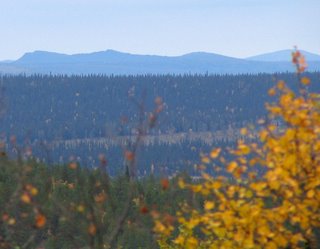 When the name for the SMEAR-station of Varrio was originally (1991) under consideration, the first suggestion included Korvatunturi fell and Santa Claus, into something like "Santa Claus forest ecological station". This is no wonder as the Santa Claus land is in the horizon just behind the station. Occasionally, when exceptionally clear weather and clean near atmosphere prevail it is possible to see silhouettes of two mountains as three-peaked fells. In the upper photo to the left the remote Juuoiva fell is seen behind the SMEAR climate tower. It is one the Russian border mountains.
When the name for the SMEAR-station of Varrio was originally (1991) under consideration, the first suggestion included Korvatunturi fell and Santa Claus, into something like "Santa Claus forest ecological station". This is no wonder as the Santa Claus land is in the horizon just behind the station. Occasionally, when exceptionally clear weather and clean near atmosphere prevail it is possible to see silhouettes of two mountains as three-peaked fells. In the upper photo to the left the remote Juuoiva fell is seen behind the SMEAR climate tower. It is one the Russian border mountains.In the lower photo to the right we can see the nearer Korvatunturi fell. The direct distance to from Varrio Research Station to Korvatunturi is 38 km. The border between Finland and Russia goes through the middle peak. Far in the right we can still se a fourth peak. It is on the Russian side, belonging to the distant Joutsenpaat -fells.
The photographing direction in these exceptionally clear weather photos was north of Rakitsa hill.
Tuesday, September 19, 2006
Räkättien muuttoa / Migration of Fieldfare
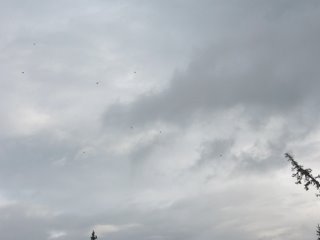
Räkättirastas muuttaa säännöllisesti Itä-Lapin alueella syksyllä länsiluoteeseen, n. 290 astetta kompassissa. Tämän olen pannut jo usean vuoden merkille, myös kirjaten havaintoja ylös. Tilanne on kaikkialla Itä-Lapissa sama, Värriöltä alkaen Kemijärveä-Etelä-Sallaa myöten. Yleensäkin niillä muuttosuunta on juuri tämä sama. Etelän suuntaan menevät ovat suorastaan poikkeuksia, vain muutama yksittäinen lintu tai muutaman yksilön parvi on mennyt etelän suuntaan.
Räkätti näyttää olevan päivämuuttaja, toisin kuin pikkurastaat. Pikkurastailla muuttosuuntakin on ilmeisesti eri.
Tässä havaintoja tältä päivältä: 35-40 yks. Rakitsan E-rinteellä suuntaan NW klo 10.28,
6 yks. Rakitsan E-puoli NW-W klo 10.40. Sauoivan NW-puolella kovasti räkättejä, etupäässä paikallisia, lentelivät sinne tänne, myös punakylkiä samoin. Saun N-puoli Haukkakuru, kymmeniä räkättejä useissa parvissa iltapäivällä lennossa NW-W.
Mielenkiintoista olisi tietää räkättien muuttoreitti. Uskon niiden tulevan Venäjältä, päätyen jonnekin Pohjanmeren rannoille. TH
Fieldfare moves to the NW (direction 290 degrees in compass)regularly in eastern Lapland, which I have noticed already many years. I have also written to notebook observations. The situation is the same always in E-Lapland, from Värriö to Kemijärvi and southrn Salla, too. Usually the direction of migration is this. Birds going to the S are exceptions, only small flocks or lonely birds have gone to the S.
Fielfare seems to migrate on day-time, in other way than smaller thrushes do. The direction of migration is different with smaller ones.
Observations of this day: 35-40 birds over the E slope of Rakitsa-hill to the NW at 10.28.
6 birds to the NW-W on the E side of Rakitsa at 10.40. On the SW-side of the fell Sauoiva a lot of Fieldfares, local ones or flying to all directions. Also Redwings were there. N-side of Sauoiva, gully by the name Haukkakuru - many flocks of Fieldfares flying to the NW-W in the afternoon.
It would be intresting to know the migration route of Fieldfares. I believe they come from Russia and go somewhere to coasts of North Sea.
Дрозд-рябинник отлетает регулярно на северо-запад-запад (на компассе 290 градусов) на территорий восточной Лапландий. Это я замечаю уже в течений многих лет, и записываю наблюдения. Ситуация такая же везде в восточной Лапландий, из Вярриё до Кемиярви и южной Саллы. Вообще направление отлета именно то же, и птицы летающие на юг, это исключения из правила. Только некоторые одинокие птицы или маленькие стайки летали на юг.
Кажется, что рябинники мигрируют днем, по-другому как маленькие дрозди. Наверно и направление отлета другое.
Тут сегодняшные наблюдения: стая 35-40 особей на северо-запад над восточным склоном
Ракитса 10.28. Стайка 6 птиц на северо-запад-запад на восточной стороне Ракится 10.40.
На северо-запад от г. Сауоива много рябинников, преймущественно местные, которые летали туда сюда. Были там и белобровики. Северная сторона Сауоива, Хауккакуру-
ущелье: десяти рябинников во многих стаях летели на северо-запад-запад во второй половине дня.
Интересно было бы узнать маршрут отлета рябинника. Я верю, что они прилетают из Россий и кончают свой путь где-то на берегах Северного моря.
Hirvien kiima-aika / The mating time of moose
17.9. löysin pari pahanhajuista kiimakuoppaa Rakitsan SE-puolelta. TH
Today I met a moose on the middle of the day on Välioja-creek. He came to a distance 40-50 meters, giving a silent voice. A male with 12-spiny horns obviously thought, that I was female. Very well seen, I got camera, but the digital thing did not work. Too late after stopping the current, it started like baffled to work.
17.9. I found two mating pits, smelling very bad on the E-side of Rakitsa.
Сегодня ко мне пришел лось на расстоянию 40-50 м в середине дня на ручее Вялиоя.
Самец лопато-рогач с 12-ми зубцами наверно считал, что я самка. Хорошо видно, взял фотоаппарат, а эта дигитальная вещь не работала. Слишком поздно, пока я не успел выключить и включить ток, она стала как сконфуженно работать.
Monday, September 18, 2006
Nuortin matka / A visit to Nuorttitunturi-fell


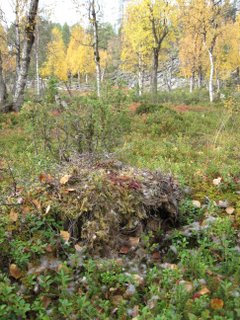
Matkallani Nuorttitunturiin pakeni kanahaukka suinpäin orava kynsissään Kotkakurulla klo 11.30. Oravaa en nähnyt, kylläkin sen jätteitä kannon päällä, missä haukka oli aterioinut. (kuva oik. voi klikata suur.)
Nuorttitunturissa vanha maakotkapari tuli tunturin yli pohjoisesta hiljaa kitisten klo 14.25. Kääntyivät sitten itään häviten sinne.
Tunturin S-puolella poroaidan takana jäkälikkö kasvaa. Kävin siellä edellisen kerran kuvaamassa yli 5 vuotta sitten. Kuvasin dialle paikassa, josta on kuva yläpuolella, ja ero on selvä. Yleisestikin jäkäliköt olivat paisuneet. TH
When I was going to Nuorttitunturi, Goshawk escaped
on the valley Kotkakuru, squirrel with him. I didn't see the squirrel, but I found the place where the hawk was having
lunch, paid by the squirrel.
On the fell Nuorttitunturi an old pair of Golden Eagles flew from the N over the fell in a low squeiking voice, and turned to E at 14.25.
On the S-side of the fell behind the reindeer fence cover of lichen is growing. I was there fotographing more than 5 years ago. I fotographed slides at this place (foto above), and the difference is clear. In general lichens have got wider.
Когда я ходил на сопку Нуорттитунтури, ястреб-тетеревятник улетел на долине Коткакуру, с белкой в когтях в 11.30. Белки я не видел, но нашел место, где ястреб кормился белкой. (фото справо)
На Нуорттитунтури старая пара беркутов пришли с севера над южный склон тихо пищая. Потом они свернули на восток, куда изчесли в 14.25.
На южной стороне сопки за забором ягел растет. Я фотографировал там слайди в том месте, которое видно в фотографиях, и разница ясно видимая. В общем, ягелные территории распухли.
Rastasmuutto vauhdissa / Thrushes are moving

Rastaat muuttavat, yötaivaalta kuuluu punakylkien "tsii"- ja laulurastaiden "tsik"-ääniä. Päivällä taas räkätit menevät luoteenvoittoisiin ilmansuuntiin, myös kulorastaan särinä
on yleinen kuultava. Kuvan punakylki levähti saunan portaiden kaiteella aamulla puoli kymmenen maissa, liekö ollut väsynyt pitkästä yömatkasta, vaiko törmännyt johonkin.
Kuitenkin päästyäni lähelle, lintu piristyi ja lensi normaalisti rantapensaikkoon. TH
Thrushes are moving, in the night-sky you can hear voices of Redwings "tsii" and Song
Thrush "tsik". On the day-time Fieldfares are flying to directions near to NW, also voice
of Mistle Thrush is common. In the picture Redwing was resting on the railing of the stairs of sauna at 9.30 . Either he was tired from the long nightly trip or hit against something. However, when I got near to him, he flew normally to bushes of the bank.
Дрозди отлетают, на ночной небе можно слышать звуки белобровиков "тсии" и певчих дроздов "тсик". Днем рябинники идут по северозападным сторонам, и звук дерябы тоже
обыкновенный. Белобровик на фото отдыхал на лестнице сауны, или он устал от долгого
ночного пути или столкнулся с чем-то. Но, пока я не попал близко к нему, он улетел нормално к береговым кустам.
Muuttolintuhavaintoja ym./ Observations of migratory birds
- sinirinta 7.9. Nuorttiaavalla yht. 2 yks.
- lapinsirkku 7.9. yht. 4 yks. Puolivälinjänkä, 8.9. 2 yks. Puolivälinmäki.
- taivaanvuohi 7.9. 1 yks. Puolivälinjänkä.
- leppälintu 7.9. 1 yks. Värriöoja.
- metsähanhi 8.9. 8 yks. parvi Lintukurun S-puolitse W klo 9.30.
- hippiäinen 8.9. 1 yks. Puolivälinjängän N-puoli.
- kahlaajaparvi (ehkä suokukkoja) 8.9. toistakymmentä yksilön parvi Pitkävuotso.
- joutsen 8.9. 12 yks. parvi SW päin Marjarova 14.45.
- hiiripöllö 8.9. 1 yks. lennossa W klo 13.40 Pitkävuotso. 14.9. 1 yks. männyn latvassa
Marjarova 12.45.
- rautiainen 14.9. 1 yks. lennossa S 11.30, Pahasrovanselkä.
- räkättirastas 14.9. n. 60 yks. parvi NW yli Sokliaavan 13.30. 17.9. 9 yks. N klo 13.50,
Hirvasjoki. 18.9. 5 yks. Kuutsjärven S-puolitse NW-W klo 9.12.
- punarinta 18.9. 1 yks. Kuutsjärvellä aamulla. TH
Latest observations:
- Bluethroat (Luscinia svecica) 7.9. in total 2 birds on Nuorttiaapa-mire.
- Redstart (Phoenicurus phoenicurus) 7.9. 1 bird Värriöoja-creek.
- Lapland Bunting (Calcarius lapponicus)7.9. in total 4 birds on Puolivälinjänkä. 8.9. 2 flying above Puolivälinmäki.
- Snipe (Capella gallinago) 7.9. 1 bird Puolivälinjänkä.
- Willow Warbler (Phylloscopus trochilus) 7.9. few birds.
- Bean Goose (Anser fabalis) 8.9. flock 8 birds flying W on the S-side of Lintukuru-gully at 9.30.
- Goldcrest (Regulus regulus) 8.9. 1 bird to the N from Puolivälinjänkä.
- flock of Waders ( Ruffs?) 8.9. over 10 birds on Pitkävuotso-mire at 13.40.
- Whooper Swan (Cygnus cygnus) 8.9. 12 birds flying to the SW over Marjarova-hill at 14.45.
- Hedge Sparrow (Prunella modularis) 14.9. 1 flying to S at 11.30 Pahasrovanselkä-hill.
- Fieldfare (Turdus pilaris) 14.9. flock about 60 birds flying to NW over Sokliaapa-mire at 13.30. 17.9. flock
9 birds flying to N on Hirvasjoki at 13.50. 18.9. flock 5 birds to NW-W on Kuutsjärvi at 9.12
- Robin (Erithacus rubecula) 17.9. 1 bird on Kuutsjärvi in the morning.
- Hawk Owl (Surnia ulula) 8.9. 1 bird flying to W over Pitkävuotso at 13.40. 14.9. 1 on pine
at Marjarova 12.45.
- варакушка 7.9. всего 2 птицы на Нуорттиаапа.
- горихвостка 7.9. 1 птица на ручее Вярриёоя.
- лапландский подорожник 7.9. всего 4 особь на Пуоливалинянка. 8.9. 2 летели
на юго-восток через Пуоливалинянганмяки.
- бекас 7.9. звук на Пуоливалинянка.
- пеночка 7.9. некоторые.
- гусь-гуменник 8.9. стая 8 особей на зарад на южной стороне ущелья Линтукуру 9.30.
- королёк 8.9. 1 птица на север от Пуоливалинянка.
- стая куликов 8.9. больше 10 особей (кажется турухтаны) на болоте Питкавуотсо 13.40.
- лебедь-кликун 8.9. стая 12 особей на юго-запад через сопку Марярова в 14. ч.
- лесная завирушка 14.9. 1 летела на юг через сопку Пахасрованселка 11.30.
- дроздь-рябинник 14.9. стая ок. 60 особей на северо-запад через болото Соклиаапа 13.30.
17.9. стая 9 особей на север у реки Хирвасйоки 13.50. 18.9. 5 птиц на северо-запад-запад
через Куутсярви 9.12. ч.
- зарянка 17.9. 1 птица у Куутсярви утром.
- ястребиная сова 8.9. 1 птица на запад через Питкавуотсо 13.40. 14.9. 1 на верщине сосны
на Марярова 12.45.
Sunday, September 17, 2006
Mertsänrajakuusia - Norway spruces on the timber line

Ehkä yleisemmän käsityksen mukaan viimeisenä havupuuna metsänrajalla pidetään mäntyä. Se ehkä pitääkin paikkansa hiekkatievaisilla kankailla. Viljavalla maaperällä kuusi voi olla viimeinen havupuu yhtä hyvin, kuten tässä Värriö kakkosen itärinteessä. Vaikka rinne on kivirakkainen, maaperä on serpentiinipitoisesta johtuen kuuselle riittävän viljavaa - siellä missä maata kivirakan välissä on.
A common, maybe prevailing opinion in Finnish Lapland is the the last conifer on the timber line is the Scots pine. This may be true in western Lapland, where the soils are often sandy and less fertile. In eastern Lapland the soils are often derived from more calcareous bedrock, or from serpentine -originated rocks like in Varrio fells. Such soils are fertile enough for Norway spruce to be the last border line conifer, like here in the eastern slope of Varrio peak two.
Saturday, September 16, 2006
Sokosti näkyi - Sokosti fell seen in the horizon
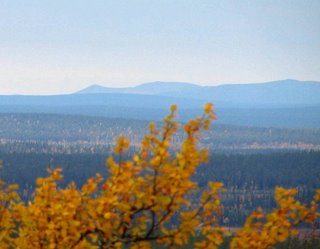 Syyskuun 16. oli vielä edellistä päivääkin kirkkaampi. Pohjoisvirtaus oli puhaltanut pölyn pois lähi-ilmakehästä ja Värriöstä katsottaessa Saariselän tunturiketjun läntisin tunturi, etelärinteeltään jyrkähkö Sokosti näkyi selvästi. Tällainen näkyvyys vallitsee vain muutaman kerran vuodessa.
Syyskuun 16. oli vielä edellistä päivääkin kirkkaampi. Pohjoisvirtaus oli puhaltanut pölyn pois lähi-ilmakehästä ja Värriöstä katsottaessa Saariselän tunturiketjun läntisin tunturi, etelärinteeltään jyrkähkö Sokosti näkyi selvästi. Tällainen näkyvyys vallitsee vain muutaman kerran vuodessa.The sky on September 16 was still more transparent and clearer than the previous days. The northern spell had blows the dust and mist away. Looking from Varrio the westernmost fell in the Saariselka massif, the Sokosti fell with her steep slope was seen clearly. Such a visibility occurs only few times per year.
Friday, September 15, 2006
Kynttiläkuusia ruskassa - Candle spruces and autumn colors

Hirvasjoen laakson kynttiläkuuset erottaa lehtipuista parhaiten ruskan huipun aikaan. Kuva Värriö kakkoselta kaakkoon.
The candle spruces in the Hirvas river valley can best be separated from the plenty of downy birches in the peak time of autumn colors.
Thursday, September 14, 2006
Kannuslaiset tunturissa - Kannus Forest Research Station staff on Varrio fells
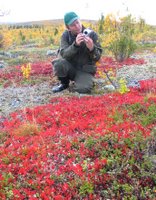 Kannuksen metsäntutkimusaseman henkilökunta vieraili Värriön tutkimusasemalla (ks. Luontopäiväkirjan merkintä 5.9.2006). Oikeanpuoleisessa kuvassa retkikunnan pääkoordinaattori, maisteri Esa Heino tarkastaa tunturiin levitetyn punaisen maton (Arctostaphylos alpinus).
Kannuksen metsäntutkimusaseman henkilökunta vieraili Värriön tutkimusasemalla (ks. Luontopäiväkirjan merkintä 5.9.2006). Oikeanpuoleisessa kuvassa retkikunnan pääkoordinaattori, maisteri Esa Heino tarkastaa tunturiin levitetyn punaisen maton (Arctostaphylos alpinus).Vasemmassa kuvassa 14 hengen vierailijoukko Värriö ykkösen pohjoisrinteellä, kuvan oikeassa laidassa tutkimusaseman johtaja Jussi Saramäki.
Syyskuun 14. päivän ilma oli alkavan pohjoisvirtauksen ansiosta poikkeuksellisen puhdas, ja saatoimme nähdä Korvatunturin kolmihuippuisen silhuetin (kuva alhaalla oikealla).
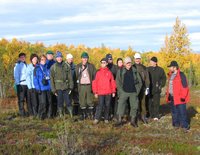 Tarunomainen Joulupukin maa herätti retkikunnassa ihastuneita huudahduksia, ja niinpä päätimme kajauttaa Värriötunturin rinteeltä kolminkertäisen Eläköön! -huudon Korvatunturille.
Tarunomainen Joulupukin maa herätti retkikunnassa ihastuneita huudahduksia, ja niinpä päätimme kajauttaa Värriötunturin rinteeltä kolminkertäisen Eläköön! -huudon Korvatunturille.The visitors from Kannus Forest Research Station arrived in Varrio (see Nature Diary blog post of 5 September), and made an expedition to the Varrio fells. In the photo above right, the tour leader, Magister Mr. Esa Heino checks the red carpet of Arctostaphylos alpinus on Varrio peak one.
 In the the photo to the left the expedition of 14 team members in a group photo on the northern slope of Varrio peak one. The rightmost person in red jacket is Dr. Jussi Saramaki, Director of Kannus Research Station.
In the the photo to the left the expedition of 14 team members in a group photo on the northern slope of Varrio peak one. The rightmost person in red jacket is Dr. Jussi Saramaki, Director of Kannus Research Station.Slight northern spell prevailed on 14 September, the air was exceptionally clear and we could see the three-peaked silhouette of Korvatunturi fell (the photo to the right, below). The appearance of the mythical fell of Santa Claus released delighted sighs in the expedition members, and spontaneosly we decided to raise three fold call "Hurrah to Korvatunturi fell ! " to the atmosphere.
Wednesday, September 13, 2006
Ruskapitkospuut - Wooden track to Varrio Nature Reserve


Värriön tutkimusasemalla johtavat pitkospuut kulkevaat ruskaan tulleen Puolivälinjängän ylitse.
The wooden track towards Varrio Research Station passes through Puolivalinjanka aapa mire which has turned into autumn colors
Tuesday, September 12, 2006
Lehtiruska huipussaan - Autumn colors in Varrio Nature Reserve
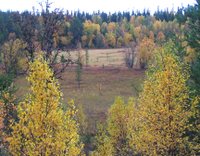
 Lehtiruska ja soiden maaruska alkaa olla Värriön luonnonpuistossa huipussaan, kuten Nuorttiahon jängällä (vasen kuva) ja Puolivälinjängällä. Vieläkään kunnon yöpakkasta ei ole ollut.
Lehtiruska ja soiden maaruska alkaa olla Värriön luonnonpuistossa huipussaan, kuten Nuorttiahon jängällä (vasen kuva) ja Puolivälinjängällä. Vieläkään kunnon yöpakkasta ei ole ollut.The change into autumn colors is in the peak in trees and aapamires, like in Nuorttiaho´s mire (left) and in Puolivalinjanka mire (right). There has been no night frosts, which is believed to trogger the turning of the colors. The day length and the angle of the Sun in the autumn may have more to say in this phenomenon than the low night temperatures.
Monday, September 11, 2006
Haapoja Syväkurun takana - Trembling aspens behing Deep Gorge
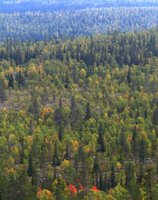
 Täysikasvuisia haapoja kasvaa Värriön luonnonpuistossa vähän, niin vähän että maastossa kulkija ei niitä tule juuri panneeksi edes merkille. Parhaiten haavat erottuvat ruskaan menevästä syysmetsästä. Usein ne hohtavat metsämeressä yksittäisinä punaisina laikkuina, kuten kuvissa Syväkurun takana, Hirvasjoen latvoilla, kuvattuna Värriö kakkosen itärinteeltä kaakkoon.
Täysikasvuisia haapoja kasvaa Värriön luonnonpuistossa vähän, niin vähän että maastossa kulkija ei niitä tule juuri panneeksi edes merkille. Parhaiten haavat erottuvat ruskaan menevästä syysmetsästä. Usein ne hohtavat metsämeressä yksittäisinä punaisina laikkuina, kuten kuvissa Syväkurun takana, Hirvasjoen latvoilla, kuvattuna Värriö kakkosen itärinteeltä kaakkoon.Vesasyntyistä haavanvesakkoa kasvaa tuntureissa paljon enemmän, mutta vesat saavuttavat harvoin ison puun mitat.
Trembling aspen (Populus tremula) is rather rare near to the tree line in Eastern Lapland. In Varrio Nature Reserve you do not notice big trees often while walking through the wilderness. The best time to spot the trembling aspens is in autumn when the broadleaved tress turn yellow - or to red like these three aspens that grow behind Deep Gorge. The photos have been taken east of Varrio peak two.
Low-growing coppicing trembling aspens grow in quite a number in Varrio, even inside the mountain birch forest, but the coppices seldom grow into size of big trees.
Sunday, September 10, 2006
Mustaa mustikkaa - Black bilberry
 Miksi tavallisen sinisen mustikan seassa kasvaa joitakin, sinertävän himmeisiin tavallisiin mustikoihin verrattuna selvästi tummempia, mustia mustikoita?
Miksi tavallisen sinisen mustikan seassa kasvaa joitakin, sinertävän himmeisiin tavallisiin mustikoihin verrattuna selvästi tummempia, mustia mustikoita?Kyseessä on toki sama mustikka, mutta jostakin syystä toisiin varpuihin syntyy vahakerroksen peittämiä sinisiä mustikoita, ja toisiin varpuihin (paljon harvemmin) mustia mustikoita, joissa vahakerrosta ei ole. Mustia mustikoita kutsutaan paikalliskielessä "voimustikoiksi". Kyseessä lienee vain geneettinen vaihtelu eri kasviyksilöiden välillä. Eri väristen mustikoiden maussa ei liene eroa.
Why all the bilberries are not blue, why some of the berries are shining black? It is the same plant, Vaccinus myrtillus. The blue ones hawe clear wax that covers the outer skin of the berry. For some reason, the wax is missing in some plants, apparently just due to genetical variation. A closer look reveals that the black berries are always in a different plant (speceimen) than the blue ones. - There is no taste difference between the blue and black berries and the berries are not sorted when picking.
Saturday, September 09, 2006
Taivaallista vettä poimulehdessä - Heavenly water in Lady's mantle
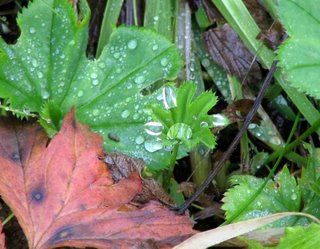 (Alchemilla sp.) ja siinä pisaroiva vesi, kuten kuvan Rakitsankurussa kasvavassa yksilössä.
(Alchemilla sp.) ja siinä pisaroiva vesi, kuten kuvan Rakitsankurussa kasvavassa yksilössä.Poimulehti on helppo tunnistaa lehdestään, johon kostealla säällä muodostuu kastepisaroita. Kyseessä on juuripaineesta johtuva ilmiö, guttaatio eli pisarointi.
Guttaation puskema "taivaallinen vesi" on synnyttänyt erilaisia uskomuksia poimulehden vaikutuksista. Niihin viittää myös kasvin tieteellinen sukunimi Alchemilla.
Poimulehteä käytetään muun muassa yrttinä ja siitä valmistetaan teetä. Poimulehti sisältää runsaasti C-vitamiinia sekä erilaisia parkkiaineita ja orgaanisia happoja.
Lady's mantle (Alchemilla sp.) has an interesting phenomenon in its leaves, called guttation. It is caused by root pressure, which in the night forces the xylem sap to drop on the leaves, as is seen in the photo taken in Rakitsa valley of Varrio Nature Reserve. Guttation fluid may contain a variety of organic compounds, like sugars, and mineral nutrients, mainly potassium.
Due to its fascinating morning appearance the water itself and the whole plant is believed to have nutritious and heeling characteristics to man. This has influenced also to the naming of the plant as Alchemilla. In Finland the guttation water of Lady´s mantle is sometimes called "heavenly water". Lady's mantle is used as herb and as tea. It is known to have high content of C vitamine.
Friday, September 08, 2006
Tunturimittareita haaviin - Sweeping for Epirrita autumnata

Tunturimittarin (Epirrita autumnata) havainnointi on eräs Värriön tutkimusaseman pitkäaikaisimpia tutkimussarjoja. Se alkoi 1977. Tunturimittarit löytyvät parhaiten tunturikoivikon alla olevasta mustikan varvikosta. Varvikko haavitaan määräalalta kasvukauden aikana joka viides päivä. Kuvassa tunturimittaria haavimassa Teuvo Hietajärvi (ks. myös luontopäiväkirjan merkintä e.9.2006.
Kasvukauden aikana kerätyt tunturimittarin toukat ja perhoset lasketaan ja pakastetaan myöhempiä tutkimuksia varten.
Monitoring the autumnal moth, Epirrita autumnata, is one of the longest observation series in Varrio Research Station. It started already in 1977. Epirrita autumnata is best found in the bilberry-dominated bottom layer vegetation, in the Downy birch forest zone of the fells. The bilberries are sweeped with a butterfly net. This is done every fifth day throughout the growing season. In the photo Mr. Teuvo Hietajarvi is sweeping the ground.
The butterflies and the larvae are counted and stored as frozen for further studies.
Thursday, September 07, 2006
Lisää käpylinnun syyspesinnästä - More about autumn nesting of Common crossbill
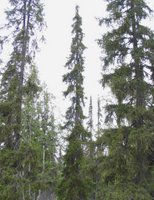 Teuvo Hietajärven löytämä pikkukäpylinnun syyspesä (ks. Luontopäiväkirjan merkintä 31.8.2006) on oikealla olevan kuvan keskellä olevassa kuusessa, vajaa metri kuusen latvasta alaspäin, kuusen rungon oikealla puolella olevassa oksan tihentymässä. Tihentymä näkyy suurempana alemmassa kuvassa vasemmalla. Naaras on hautomassa rungon oikealla puolella oksien keskellä, käpyjen takana.
Teuvo Hietajärven löytämä pikkukäpylinnun syyspesä (ks. Luontopäiväkirjan merkintä 31.8.2006) on oikealla olevan kuvan keskellä olevassa kuusessa, vajaa metri kuusen latvasta alaspäin, kuusen rungon oikealla puolella olevassa oksan tihentymässä. Tihentymä näkyy suurempana alemmassa kuvassa vasemmalla. Naaras on hautomassa rungon oikealla puolella oksien keskellä, käpyjen takana.Pikkukäpylinnun syyspesintä tunnetaan Keski-Euroopassa, muun muassa Iso Britanniassa, jossa sen on todettu pesineen vuoden jokaisena kuukautena. Pohjois-Suomessa, tai ylipäänsä Suomessa syyspesinnästä on niukasti varmoja havaintoja. Syksyisin nähtyjen verraten myöhäisten poikasten perusteella on päätelty, että syyspesintää on. Suomen olojen pesintä kylmässä, lyhyessä päivässä ja pitkässä yössä on joka tapauksessa eri asia kuin pesintä lämpimämmässä ja valoisammassa Keski-Euroopassa.
 Parhaiten myöhäistä pohjoisten olojen pikkukäpylinnun syyspesintää on tutkittu Lapin luonnonpuistossa Venäjän Kuolassa. Syyspesintä liittyy kuusen runsaaseen käpysatoon, mikä on tilanne syksyllä 2006 myös Värriön luonnonpuistossa. Pikkukäpylintu osaa "päätellä" lähestyvästä kuusen käpysadosta, milloin syyspesintään voi mennä. Lapin luonnonpuiston havaintojen mukaan napapiirin takaisissa oloissa ainoastaan riittävä kuusen käpysato mahdollistaa myöhäisten poikueide selviämisen ja käpylinnun selviytymisen pitkän ja pimeän talven yli.
Parhaiten myöhäistä pohjoisten olojen pikkukäpylinnun syyspesintää on tutkittu Lapin luonnonpuistossa Venäjän Kuolassa. Syyspesintä liittyy kuusen runsaaseen käpysatoon, mikä on tilanne syksyllä 2006 myös Värriön luonnonpuistossa. Pikkukäpylintu osaa "päätellä" lähestyvästä kuusen käpysadosta, milloin syyspesintään voi mennä. Lapin luonnonpuiston havaintojen mukaan napapiirin takaisissa oloissa ainoastaan riittävä kuusen käpysato mahdollistaa myöhäisten poikueide selviämisen ja käpylinnun selviytymisen pitkän ja pimeän talven yli.Männyn hyvä käpysato ei siihen riitä, sillä jäätyneet männynkävyt ovat pikkukäpylinnulle liian työläitä avata keskitalven aikaan, jotta linnut saisivat niistä lyhyen valoisan aikana riittävästi energiaa pitkän yön pimyden yli. Siksi napapiirin takaiset pikkukäpylinnut lähtevät vaeltamaan sellaisinakin vuosina, kun männyllä on hyvä käpysato. Kuusen siemenet ovat sen sijaan jäätyneenäkin pehmeämpiä ja ilmeisesti ravitsevampia, koska pikkukäpylintu uskaltaa tehdä niiden varaan myöhäisiä poikueita, ja myös talvehtii hyvinä kuusen siemenvuosina napapiirin takana.
The common crossbill nest that Teuvo Hietajarvi found (see Nature Diary post 31.8.2006) is found in the top of a Norway spruce. See the photograph in the right, the spruce is the one in the middle. The nest high in the top, about one meter down from the top. In the left side photo the nest is found inside the cones, right side of the tree in the conglomerate of branches. The nest was found by following the movements of male and female crossbill; at the time of photographing the female was hatching and the male came regularly to give some feed to the hatching female.
Wednesday, September 06, 2006
Mikä söi mustikan lehdet?/ Who ate leaves of bilberry?

Tänään käydessäni Petäjärinteellä havaitsin, että mustikan lehdet oli hävinneet laajoilta aloilta mäntykankaalla. Myös puolukan lehtiä oli syöty, koivut oli säästyneet. Mikähän oli asialla? Tunturimittareita on ollut tänä kesänä vain vähän tunturissa. TH
Today when I was at the forest Petäjärinne, I noticed that leaves of bilberry had disappeared on large areas. Also leaves of lingonberry had been eaten, birches had saved. What is the reason? There have been only a few fell measuring worms on the fells this summer.
Сегодня когда я побывал в лесу Петаяринне я заметил, что листья черники съедены на широких ареалах на борах. Тоже съели немного листъев брусники, только березы спасимые. В чем причина? Горных червей мало было у нас этим летом.
Tuesday, September 05, 2006
Punainen matto tunturiin - Red carpet on the fell

Odotamme Värriön tutkimusasemalle arvovieraita Metsäntutkimuslaitoksen Kannuksen tutkimusasemalta. Punainen matto (Arctostaphylos alpinus) on jo levitetty tunturiin.
We are waiting for VIP visitors from Kannus Forest Research Station of the Finnish Forest Research Institute. Our red carpet (Arctostaphylos alpinus) has already been spread out on the Varrio fell to wait for them.
Monday, September 04, 2006
Kynsivaaran kynsi - Claw of Kynsivaara hill

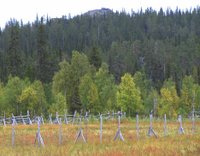 Nuorttiaavan eteläpuolella kohoaa vaara, jossa on erikoinen kallionkieleke. Kyseessä on rajavyöhykkeellä sijaitseva Kynsivaara. Kynsivaaran kynsi erottuu etenkin oikean puoleisessa kuvassa (klikkaa kuvaa isommaksi). Kynsivaaran laella on historiallinen tähystyspaikka itään, kivistä kasattu potero, josta on menneinä aikoina seurattu naapurin liikkeitä.
Nuorttiaavan eteläpuolella kohoaa vaara, jossa on erikoinen kallionkieleke. Kyseessä on rajavyöhykkeellä sijaitseva Kynsivaara. Kynsivaaran kynsi erottuu etenkin oikean puoleisessa kuvassa (klikkaa kuvaa isommaksi). Kynsivaaran laella on historiallinen tähystyspaikka itään, kivistä kasattu potero, josta on menneinä aikoina seurattu naapurin liikkeitä.Looking to south of Nuorttiaapa mire you will see a peculiar hilltop. In Finnish the hill is called "Hill with claw". The claw, the peculiar formation on the top, is seen especially in the right-hand photo (click the photo for bigger view).
Sunday, September 03, 2006
Nuortin lähteet - The sources of Nuortti river
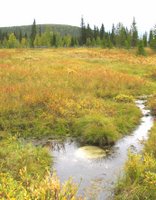 Itä-Lapin maineikas kalastusjoki, Nuortti saa alkunsa Värriön luonnonpuiston pohjoisosasta, Nuorttitunturin juurelta. Alkupurot yhtyvät Nuorttiaavalla Ylinuortti-nimiseksi latvajoeksi. Vedet virtaavat ensin kohti länttä, mutta Nuortin pääuoma laskee jo koilliseen, ja se ylittää Venäjän rajan UKK-puiston alueella. Kuvassa oikealla on eräs latvahaaroista, mikä lähtee Nuorttiaavan perältä, Kynsivaaran kainalosta (taustalla Nuorttitunturi).
Itä-Lapin maineikas kalastusjoki, Nuortti saa alkunsa Värriön luonnonpuiston pohjoisosasta, Nuorttitunturin juurelta. Alkupurot yhtyvät Nuorttiaavalla Ylinuortti-nimiseksi latvajoeksi. Vedet virtaavat ensin kohti länttä, mutta Nuortin pääuoma laskee jo koilliseen, ja se ylittää Venäjän rajan UKK-puiston alueella. Kuvassa oikealla on eräs latvahaaroista, mikä lähtee Nuorttiaavan perältä, Kynsivaaran kainalosta (taustalla Nuorttitunturi).Nuorttitunturin sekä Kynsivaaran vedet purkautuvat jängän läpi paineella kahdeksi lähteeksi, joista vesi pulppuaa useista suonista (kuvassa etualalla suurempi lähde). Lähteiden pohjan hiekka kuohuu taukoamatta (kuva vasemmalla ja alhaalla oikealla). Katso myös video.
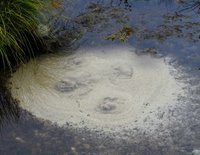 The famous fishing river of Eastern Lapland, Nuortti river, has its origins in the northern part of Varrio Nature Reserve. The sources of Nuortti are found on the foothills Nuortti fell. One of the small creeks starts at the far end of Nuorttiaapa mire (upper photo in the right).
The famous fishing river of Eastern Lapland, Nuortti river, has its origins in the northern part of Varrio Nature Reserve. The sources of Nuortti are found on the foothills Nuortti fell. One of the small creeks starts at the far end of Nuorttiaapa mire (upper photo in the right). In its origins the river has name Ylinuortti (upper Nuortti). It flows first westwards. After some small tributaries have joined together the main Nuortti turns Northeast and flows over Russian border in Urho Kekkonen National Park.
In its origins the river has name Ylinuortti (upper Nuortti). It flows first westwards. After some small tributaries have joined together the main Nuortti turns Northeast and flows over Russian border in Urho Kekkonen National Park.The ground waters of the small creek in the photo get their pressure in Nuortti fell and the nearby Kynsivaara hill soil profiles. The "water veins" emerge to the ground as springs in Nuorttiaapa. The pressurized water comes through several holes, through four holes in the bigger spring (photos to the left and down to the right). The sand with special gravel diameter stays in the spring and bubbles without a break. Watch also the video.
Saturday, September 02, 2006
Syyslintuja Rakitsankurussa - Autumn birds in Rakitsankuru

 Vaikka syksy tulee kalenterin ja auringonkierron mukaan, rehevissä kuruissa on silti vielä hyönteisiä, koska yöpakkasiakaan ei ole ollut. Muuttolintujen poikueet tankkaavat tätä valkuaisravintoa ennen lähtöään. Rakitsankurun (joka on oikeastaan laakso vain Rakitsanvaaran ja Värriötuntureiden välissä) alapäässä (vasen kuva) oli tänään koivuista ja kuusista kirvoja syömässä kymmenkunta pajulintua. Rakitsankurun satulassa (oikea kuva) oli taas järripeippoja koivunkäkkäröissä parikin poikuetta. Lisäksi satulasuon laiteilla lenteli pari punakylkirastasta varoitusaaääniään huudellen. Kuusen latvassa yritti lyhyttä laulusäettä taviokuurna. Se tosin lähtee muuttolinnuista viimeisenä, joinakin vuosina vasta marraskuussa.
Vaikka syksy tulee kalenterin ja auringonkierron mukaan, rehevissä kuruissa on silti vielä hyönteisiä, koska yöpakkasiakaan ei ole ollut. Muuttolintujen poikueet tankkaavat tätä valkuaisravintoa ennen lähtöään. Rakitsankurun (joka on oikeastaan laakso vain Rakitsanvaaran ja Värriötuntureiden välissä) alapäässä (vasen kuva) oli tänään koivuista ja kuusista kirvoja syömässä kymmenkunta pajulintua. Rakitsankurun satulassa (oikea kuva) oli taas järripeippoja koivunkäkkäröissä parikin poikuetta. Lisäksi satulasuon laiteilla lenteli pari punakylkirastasta varoitusaaääniään huudellen. Kuusen latvassa yritti lyhyttä laulusäettä taviokuurna. Se tosin lähtee muuttolinnuista viimeisenä, joinakin vuosina vasta marraskuussa.Although the autmn is coming based on calendar and day length, the valleys between the fells are still lush. As there have been no night frosts yet, there are enough insects in the trees for the migrating birds to feed. They want to fill their protein reserves before take off. In the lower (norther) part of Rakitsankuru valley (leftside photo) about 10 Willow warblers were eatings aphids on the branches of Norway spruces and Downy birches. By the saddle peatbog of Rakitsa (rightside photo) a school of Bramblings (mostly juveniles) were browsing the Downy birches, and a couple of Redwings were shouting their alarm calls. A lonesome Pine grosbeak tried to find its song verse in the top of Norway spruce. Pine grosbeaks are not in a hurry to go. In some years they are seen in Varrio still in November.
Friday, September 01, 2006
Pihlajanmarjoja ja tilhiä - Rowan berries and Bohemian waxwings
 Värriön hyvä marjakesä 2006 on hyvä marjakesä myös pihlajalle. Pihlajia ei näillä leveys- ja korkeusasteilla järin paljon ole, mutta marjoessaan ne ovat sitä näkyvämpiä.
Värriön hyvä marjakesä 2006 on hyvä marjakesä myös pihlajalle. Pihlajia ei näillä leveys- ja korkeusasteilla järin paljon ole, mutta marjoessaan ne ovat sitä näkyvämpiä.Pihlajanmarjojen ja tilhien runsauden välillä on tunnettu yhteys, ainakin talviseen aikaan. Mutta selittänevätkö Värriön vähäiset pihlajanmarjat sitä, miksi tilhien kesäkanta on kääntynyt Värriön luonnonpuistossa selvään nousuun.
Tilhiä (Bombycilla garrulus) ei havaittu 1980- ja 1980 -pistelaskentareiteillä ollenkaan, vaikka toki tilhen on tiedetty alueella pesineen harvinaisena läpi vuosikymmenten. Nyt, 2000-luvun puolivälissä tilhi havaitaan pistelaskentareiteillä vuosittain, keskimäärin kolme kertaa vuodessa (graafi, klikkaa kuvaa suuremmaksi). Tilhellä on meneillään selvä runsastuminen. Mutta miksi? Onko kyseessä tilapäinen ilmiö, vai onko tilhien runsastuminen pysyvää tai ainakin muutamaa vuotta pitempiaikaista? Tällaisiin kysymyksiin saamme vastauksia juuri pitkäaikaisista havaintosarjoista. Siksi lintujen kesäkuista pistelaskentareittiä kannattaa kävellä vielä jokunen vuosi tulevaisuudessakin.
 The good berry year 2006 in Eastern Lapland is good also for Rowan (Sorbus aucuparia). There are not too many Rowans at the latitudes and altitudes of Varrio Nature Reserve, but the few that grow there are the visible to see - especially in the autumn berry time.
The good berry year 2006 in Eastern Lapland is good also for Rowan (Sorbus aucuparia). There are not too many Rowans at the latitudes and altitudes of Varrio Nature Reserve, but the few that grow there are the visible to see - especially in the autumn berry time.There is a well known straight winter connection between the abundance of Rowan berries and the occurrence of European waxwings (Bombycilla garrulus). But do the few Rowans in Varrio explain why our Bohemian waxwing stock is now on a raising trend line?
In 1980s and 1990s Bohemian waxwing was absent on the spotwise bird counting lines. We knew that it permanently occupies the nature reserve and nests there as rare. It was too rare to have happened to be on counting lines that time. In 2000s Bohemian waxwing has been counted every year (graph, click for bigger view), only few times only, in mid 200s on average three times. Why so? Why are Bohemian waxwings becoming more numerous? Is this a temporary or longer-term phenomen? We need to continue the spotwise bid counting for several years more to get some light into this puzzle.